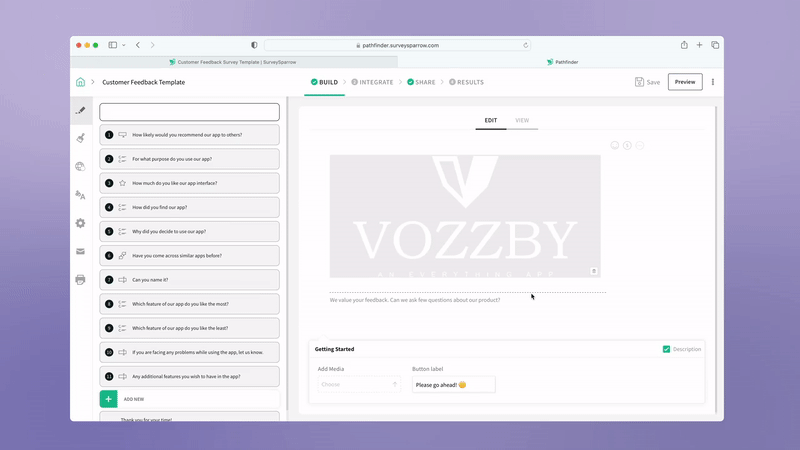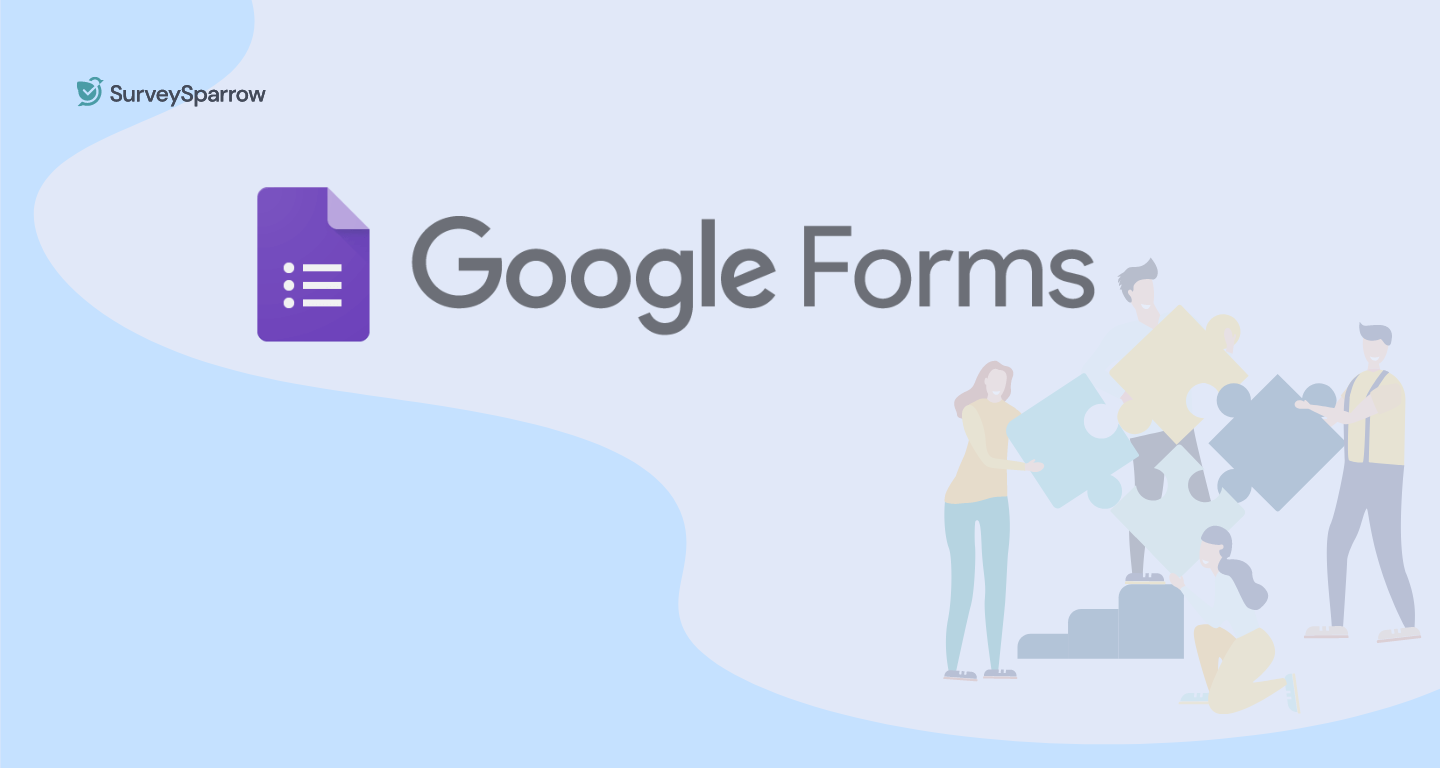Survey & Feedback
Poll vs Survey: Understand the Difference and Choose The Best For You
Article written by Kate Williams
Content Marketer at SurveySparrow
11 min read
19 September 2025

Polls vs. Surveys: Which is a better tool for collecting data? Are you stuck between a poll and a survey?
Don’t worry, I get you! It’s pretty normal! These two terms are often used interchangeably.
One of my friends recently asked me, “But aren’t they the same?” If you agree, you should know a few crucial differences between them. This blog will solve the confusion about polls vs surveys! We will examine the key differences, including definitions, benefits, types, advantages, and disadvantages.
(Psst..if you want a glance at the comparison table, jump ahead for a second!)
For the rest of us, off we go!
Why don’t we start with…
What’s a Poll?
A poll is a simple tool to gather quick opinions on specific topics.
It typically consists of a single question with limited answer choices. It’s a quick way to gauge your audience’s pulse on a particular issue. The purpose is to understand the collective views, opinions, interests, and preferences on politics, social issues, consumer preferences, and more.
There are different ways to conduct a poll. The most common methods are online questionnaires, telephone interviews, and in-person interviews.
Moreover, the results can be used in decision-making and predict future trends and patterns.
Good poll questions to ask:
- Which of the following social media platforms do you use most often?
(Facebook, Instagram, Twitter, Other) - Should the company implement a flexible work schedule?
(Yes/No) - Do you prefer working from home or in the office?
Here is a quick poll template made with SurveySparrow to give you an idea. Feel free to use and customize it if you like it.
Online Political Poll Template
Use This TemplateNow, imagine you’re running a campaign and want to know which slogan resonates the most with your audience. A poll would be your go-to tool for gathering quick feedback and making data-driven decisions on the fly.
What’s a Survey?
On the other hand, a survey has an in-depth questionnaire that tries to gather detailed information. It can have multiple questions that cover a variety of issues.
Surveys can have open-ended questions for qualitative insights. They are the best if you aim to do research, measure customer satisfaction, or map customer behavior patterns!
Here’s something for the curious minds out there…
Read More: 5 Ways to Measure Customer Satisfaction Beyond Surveys
Questions to ask in a survey:
- On a scale of 1 (very dissatisfied) to 5 (very satisfied), how satisfied are you with the quality of our product?
- Do you feel comfortable communicating your ideas and concerns to your manager? (Yes/No)
- What are your biggest challenges when [action related to your product/service]? (Open-ended)
- What features are most important when considering a [product/service category]?
(Multiple choice with options and the ability to select multiple answers)
Let’s say you’re launching a new product and want to gather comprehensive feedback from your target audience. A survey tool would allow you to collect detailed insights, opinions, and suggestions to refine your product and enhance the overall CX.
Now, let’s look at…
Types of Polls
Polls come in different shapes and sizes. Here are a few popular ones:
- Opinion Polls: These help you understand the thought process of a specific group. It involves asking the same question to a specific audience group to understand public sentiment and emotions on particular issues.
- Benchmark Poll: These polls are conducted right before a campaign is launched. This is mainly done to create a sense of familiarity and increase visibility.
- Straw Poll: It’s informal! There are no set rules or conditions for a straw poll. For instance, you might have had your manager quickly vote on the team’s agreement with one of the posed ideas! It’s pretty much like testing the waters.
- Bushfire Poll: This is conducted after a crucial event or an emergency. It collects raw information and gives insights into public opinions, perhaps right after a natural calamity.
Read More: Types of Polls: Methods and Significance
Types of Surveys
When it comes to surveys, there are different ways to collect information. Here are a few types:
- Customer Satisfaction Surveys: These measure customer satisfaction with a product/service or brand. Usually, they ask, “On a scale of 1 (very dissatisfied) to 5 (very satisfied), how satisfied are you with the quality of our product?”
- Net Promoter Score Surveys: An NPS survey measures the likelihood of customer advocacy! It is followed by “How likely would it be for you to recommend us to a friend?”
- Market Research Surveys: They collect data on the market’s businesses, products, or services. Understanding your market position is essential.
- Customer Effort Score Surveys: A CES survey is used to understand the effort a customer puts into interacting with your product, brand, or service.
Read More: What Are The Different Types of Surveys?
Advantages and Disadvantages
Let’s start with:
Advantages of Polls
- Quick feedback: Everything is instant. You can save a lot of time here!
- Engagement: The interactive and engaging element in a poll makes the audience want to participate.
- Ease of Use: Whether it is the creation or sharing, it is simple.
- Cost-Effective: Conducting polls is cost-effective compared to other research methods.
Disadvantages of Polls
- Sampling Bias: Oh yes! It is easy to get skewed poll results if your sample does not represent the target audience.
- Response Bias: Well, this is something out of our hands. Respondents can be diplomatic or elect options randomly.
- Inability to Probe: Unlike surveys, polls do not allow follow-up questions or probing. This limits the depth of analysis.
- Lack of Context: There’s no depth. You can’t read between the lines. There are no lines to begin with!
Now comes…
Advantages of Surveys
- Comprehensive Insights: It comes with various question types, including multiple-choice, open-ended, and rating scales. They provide rich, nuanced data for analysis.
- Customization: You can personalize surveys according to the target demographics, from designing questions to selecting response options and survey themes
- Quantitative and Qualitative Data: There are no limits here. You can add close-ended and open-ended questions to gather all kinds of data!
- Sampling Control: You control the sampling process. Surveys offer the flexibility to conduct random, stratified, or convenience sampling.
Disadvantages of Surveys
- Low Response Rates: Most people shy away from completing surveys because of their length and time consumption. It is important to use Conversational Surveys to tackle this problem.
Read More: Conversational Feedback: Your Guide to Conversational Surveys
- Complex Creation: It can be time-consuming to create and send out.
- Survey Fatigue: Admit it, we all have multiple surveys waiting to be filled in our inboxes, right? Fatigue happens when there is an overwhelming flow of surveys from various sources. It is important to time them.
- Difficulty in Reaching Target Audience: This applies to niche or hard-to-reach populations.
Let’s sum it up by understanding…
Poll vs Survey : When to Use Polls and Surveys
It is important to know which one is supposed to be used at what time and in what situation.
So…
When should you take a poll?
A poll should be used when you have to:
- Gauge quick opinions on a specific topic.
- Make a fast decision that doesn’t require a lot of detailed information.
- Increase audience engagement with a fun and interactive format.
When should you roll out surveys?
- Gather in-depth data about your audience’s needs, preferences, and behaviors.
- Identify trends and patterns in your data.
- Measure customer satisfaction or employee engagement.
Poll vs Survey : The Final Showdown
| Feature | Poll | Survey |
|---|---|---|
| Purpose | Gauge quick opinions on a specific topic | Gather in-depth data and insights |
| Question Types | Limited (usually multiple-choice) | Varied (multiple choice, open-ended, rating scales, demographic questions) |
| Time Commitment | Low (quick and easy to complete) | High (can be time-consuming to create and complete) |
| Participation Rates | High | Lower for Traditional Surveys |
| Data Analysis | Simple (usually presented in charts and graphs) | More complex (may require statistical analysis) |
| Anonymity | Can be anonymous | It may or may not be anonymous |
| Cost | Typically free or low-cost | It can be more expensive, depending on the complexity |
| Response Quality | Lower detail focuses on general sentiment | Higher detail allows for nuanced responses |
| Actionable Insights | Can provide quick, actionable insights for specific decisions | Provides a deeper understanding of the audience for broader strategic planning |
| Examples | What is your preferred flavor of ice cream? | What are your biggest challenges with using our product? And why? |
Let’s take a deeper look at the features:
- Focus: The primary purpose of polls is to capture a snapshot of the opinion on a specific topic or issue at a particular moment. Surveys, on the other hand, focus on gathering in-depth data to understand the “why” behind the opinions.
- Time Commitment: If you want instant feedback, a poll is the best choice. Surveys can be time-consuming for the surveyor as well as the respondent.
- Depth of Information: You get very little data with polls! Yes, you can understand what people choose, but not necessarily why they do so. Surveys allow you to delve deeper and understand the reasons, motivations, and experiences behind the responses. You get the bigger picture here!
- Flexibility: Polls are restrictive in terms of question types and response options. Surveys offer more flexibility to tailor the questions to your specific needs and gather a broader range of data.
- Decision-Making: Use polls for quick decisions that don’t require much detailed information. Surveys are better suited for making strategic decisions that require a deeper understanding of your audience.
And there you go! It’s a wrap!
Now, it’s time for you to build and collect data!
Create Engaging Polls and Conversational Surveys with SuvreySparrow
SurveySparrow’s drag-and-drop form builder lets you create and edit surveys in just a few clicks! You don’t need a coder’s brain. Moreover, the conversational surveys will fetch you 40% more responses! Well, isn’t that something?
You can create a new one from scratch or choose a pre-designed template. There are 1000+ waiting for you to customize them! Plus, AI surveys will make your job so much simpler.
Let me walk you through the process real quick!
Step 1: Sign-in
- Log in to your SurveySparrow account if you already have one.
- If not, don’t worry. You can sign up right here for a 14-day free trial.
Let me answer the question that’s lurking in your mind right away. Nope, you don’t have to share your credit card details already!

Explore Deeper Customer Insights with SurveySparrow
A personalized walkthrough by our experts. No strings attached!
Step 2: Create
Once you have your account,
- Click the “+New Survey” button to begin afresh.
To choose a template,
- Click “Browse Classic Templates” and select the one that best suits your needs.
Now comes the fun part!
Step 3: Customize
Easily navigate the builder and design the surveys and polls how you want them. Make them your own!
Here’s how you do it:

- Edit the pre-populated question fields or delete them if they don’t fit the bill.
- Add your logo, remove SurveySparrow’s branding, and customize the color, font, and theme that highlights your brand!
- The question fields can be edited with the Wing feature. You can expand, compress, rewrite, reword, or do anything with it!
Now, it’s time to merge:
Step 4: Integrate
Connect your survey with popular apps such as HubSpot, Zapier, Mailchimp, or any other integrations from the list that suit your poll or survey needs.
Step 5: Share
There you go! You have an engaging poll or a hooking survey ready to be shared!
You can send it via email or WhatsApp or embed it directly on your website. The autofill option will save your answers as drafts so that no data will be lost!
Once the responses start flowing in, visualize them on the Executive Dashboard, analyze them, and make informed decisions like a pro!

Do not hesitate to reach out if any steps are confusing or time-consuming. The support team will solve your issue in no time!
Wrap Up!
So, for Poll vs Survey, which one do you choose?
Understanding the difference between the both is crucial for gathering the correct information from your audience.
While polls are great for quick feedback and engaging your audience, surveys offer more comprehensive insights into respondent opinions and behaviors.
Choose what’s best for you. If you have any queries, I’ll be here, ready to help you through the process!
14-day free trial • Cancel Anytime • No Credit Card Required • No Strings Attached

Create engaging surveys that people actually complete. Try SurveySparrow now!
Kate Williams
Related Articles

Survey & Feedback
What is a survey? All about why you should invest in quality customer surveys!
11 MINUTES
20 February 2019

Survey & Feedback
8 Unique Types of Forms: Use Cases and Free Templates
14 MINUTES
9 December 2023

Survey & Feedback
How to Make an Escape Room on Google Forms in Just 4 Steps
10 MINUTES
25 March 2024

Survey & Feedback
Why Data Security Teams Should Use Feedback Surveys to Assess Compliance Readiness
8 MINUTES
31 October 2025
